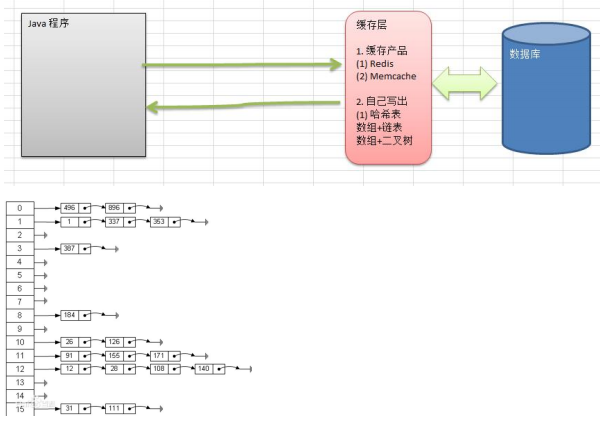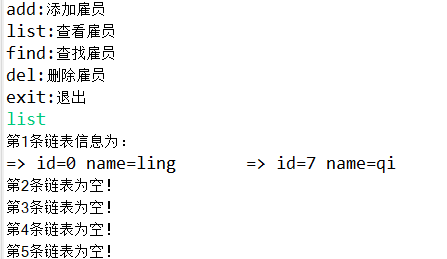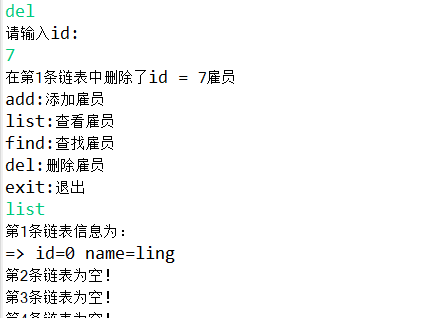讲解Java 哈希表(google 公司的上机题)
本文主要介绍"讲解Java 哈希表(google 公司的上机题)",希望能够解决您遇到有关问题,下面我们一起来看这篇 "讲解Java 哈希表(google 公司的上机题)" 文章。
1 哈希表(散列)-Google 上机题
1) 看一个实际需求,google 公司的一个上机题:
2) 有一个公司,当有新的员工来报道时,要求将该员工的信息加入(id,性别,年龄,住址..),当输入该员工的 id 时,要求查
找到该员工的 所有信息.
3) 要求: 不使用数据库,尽量节省内存,速度越快越好=>哈希表(散列)
2 哈希表的基本介绍
散列表(Hash table,也叫哈希表),是根据关键码值(Key value)而直接进行访问的数据结构。也就是说,它通
过把关键码值映射到表中一个位置来访问记录,以加快查找的速度。这个映射函数叫做散列函数,存放记录的数组
叫做散列表。

3. google 公司的一个上机题:
有一个公司,当有新的员工来报道时,要求将该员工的信息加入(id,性别,年龄,名字,住址..),当输入该员工的 id 时,
要求查找到该员工的 所有信息.
要求:
1) 不使用数据库,,速度越快越好=>哈希表(散列)
2) 添加时,保证按照 id 从低到高插入
3) 使用链表来实现哈希表, 该链表不带表头[即: 链表的第一个结点就存放雇员信息]
4) 思路分析并画出示意图

5) 代码实现
public class HashTableDemo {
public static void main(String[] args) {
HashTable hashTable = new HashTable(7);
String key = "";
Scanner scanner = new Scanner(System.in);
while(true) {
System.out.println("add:添加雇员");
System.out.println("list:查看雇员");
System.out.println("find:查找雇员");
System.out.println("del:删除雇员");
System.out.println("exit:退出");
key = scanner.next();
switch (key) {
case "add":
System.out.println("请输入id:");
int id = scanner.nextInt();
System.out.println("请输入名字:");
String name = scanner.next();
Emp emp = new Emp(id, name);
hashTable.add(emp);
break;
case "list":
hashTable.list();
break;
case "find":
System.out.println("请输入id:");
int id2 = scanner.nextInt();
hashTable.findEmpById(id2);
break;
case "del":
System.out.println("请输入id:");
int id3 = scanner.nextInt();
hashTable.del(id3);
break;
case "exit":
System.exit(10);
default:
break;
}
}
}
}// emp
class Emp{
public int id;
public String name;
public Emp next;
public Emp(int id, String name) {
super();
this.id = id;
this.name = name;
}
}// EmpLinkedList
class EmpLinkedList{
// 头指针,执行第一个Emp,因此我们这个链表的head,是直接指向第一个Emp
private Emp head;
// id是自增长的
public void add(Emp emp) {
// 如果是添加一个雇员
if(head == null) {
head = emp;
return;
}
// 如果不是第一个
Emp curEmp = head;
while(true) {
if(curEmp.next == null) {
break;
}
curEmp = curEmp.next;
}
curEmp.next = emp;
}
public void list(int no) {
if(head == null) {
System.out.println("第" + (no+1) + "条链表为空!");
return;
}
System.out.println("第" + (no+1) + "条链表信息为:");
Emp curEmp = head;
while(true) {
System.out.printf("=> id=%d name=%s\t",curEmp.id,curEmp.name);
if(curEmp.next == null) {
break;
}
curEmp = curEmp.next;
}
System.out.println();
}
// 根据id查找雇员
public Emp findEmpByid(int id) {
if(head == null) {
System.out.println("链表为空");
return null;
}
Emp curEmp = head;
while(true) {
if(curEmp.id == id) {
break;
}
if(curEmp.next == null) {
System.out.println("遍历完了,没有找到!");
curEmp = null;
break;
}
curEmp = curEmp.next;
}
return curEmp;
}
// 根据id进行删除
public boolean del(int id) {
boolean flag = false;
if(head == null) {
System.out.println("当前链表为空!");
return flag;
}
if(head.id == id) {
head = null;
flag = true;
return flag;
}
Emp curEmp = head;
while(true) {
// 找到了改雇员
if(curEmp.next.id == id) {
curEmp.next = curEmp.next.next;
curEmp.next = null;
return (flag == false);
}
// 没有找到
if(curEmp.next == null) {
System.out.println("没有找改雇员!");
curEmp = null;
return flag;
}
curEmp = curEmp.next;
}
}
}// 哈希表
class HashTable{
private EmpLinkedList[] empLinkedListArr;
private int size;
public HashTable(int size) {
super();
this.size = size;
empLinkedListArr = new EmpLinkedList[size];
for(int i = 0; i < size; i++){
empLinkedListArr[i] = new EmpLinkedList();
}
}
// 添加雇员
public void add(Emp emp) {
// 根据员工的id得到改员工应该添加到哪条链表
int empLinkedListNo = hashFun(emp.id);
// 将emp添加到对应的链表中
empLinkedListArr[empLinkedListNo].add(emp);
}
public void list() {
for (int i = 0; i < empLinkedListArr.length; i++) {
empLinkedListArr[i].list(i);
}
}
public void findEmpById(int id) {
int empLinkedListNo = hashFun(id);
Emp emp = empLinkedListArr[empLinkedListNo].findEmpByid(id);
if(emp != null) {
System.out.println("在第" + (empLinkedListNo+1) + "条链表中找到id = " + id + "雇员");
} else {
System.out.println("在哈希表中没有找到");
}
}
public void del(int id) {
int empLinkedListNo = hashFun(id);
boolean flag = empLinkedListArr[empLinkedListNo].del(id);
if(flag == true) {
System.out.println("在第" + (empLinkedListNo+1) + "条链表中删除了id = " + id + "雇员");
} else {
System.out.println("在哈希表中没有找到");
}
}
public int hashFun(int id) {
return id %size;
}
}

注意:不要把链表的第一个节点(头节点)删除了,不然整条链表没了。(还可以改良)
思考:如果 id 不是从低到高插入,但要求各条链表仍是从低到高,怎么解决?
关于 "讲解Java 哈希表(google 公司的上机题)" 就介绍到这。希望大家多多支持编程宝库。
本文主要介绍"Java8新特性之方法引用的使用方法",希望能够解决您遇到有关问题,下面我们一起来看这篇 "Java8新特性之方法引用的使用方法" 文章。 一 前言日常开发中,经常使用到 ...